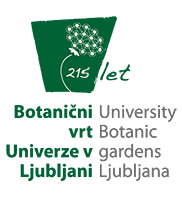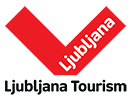Today, people often think they are self-suffi cient and can survive without nature. But that is not true. In nature, we find raw materials that we eat, use to build cities, use for clothing, curing diseases and more. Human life depends on nature and its organisms, and only in coexistence with them will human civilisation survive. Loss of habitat, fragmentation and degradation of the environment (Ouborg et al. 1991, Franklin 1980, Charlesworth & Charlesworth 1987, Barrett & Kohn 1991, Cane 2001 Laurance 2010, Bennet & Saunders 2010, Kosi 2013), excessive exploitation of environmental resources, invasive species, environmental pollution, intensive agriculture, expansion of urban areas, and subsequent climate change are the main factors causing a decrease of plant biodiversity throughout the world (Corlett 2016, APA 2019). The decrease in plant diversity also results in a decrease in animal diversity, as plants either form habitats for them or are their food. A decrease of plant diversity particularly affects pollinators, as pollen and nectar represent their food. Different groups of pollinators (bees, butterfl ies, beetles, flies, etc.) and even individual species within groups can be specialised for feeding on a particular plant species or family (Kearns & Inouye 1997, Armbruster 2016). The absence of an individual plant species can therefore cause the absence of a specific pollinator. The decrease of species diversity subsequently also affects people, because as many as 800 species (including sorts) of cultivated plants are pollinated by animals (Nicholls & Altieri 2013, ELO, EISA & ECP 2013). If there is no natural habitat in the vicinity of monoculture plantations, the density and species diversity of pollinators is lower. Plants in large monoculture plantations bloom for a specific time, thereby providing food for a limited time only. With the absence of natural pollinators, plants subsequently do not produce fruit or seed, thereby reducing the yield per hectare. For example, in certain parts of China, apple and pear tree flowers need to be pollinated by hand due to the reduction of diversity and the number of wild bees. Wild bees have disappeared because of intensive use of pesticides and the degradation of their natural habitats. Hand pollination is very demanding, time-consuming and expensive (Goulson 2012). Furthermore, for successful pollination of orchards by natural pollinators, it is also important to grow plant species under or near trees, which will provide food and home for pollinators outside the blooming season of fruit trees. They found that the quantity of fruit increased signifi cantly when more or less natural habitats of pollinators were left in the vicinity of orchards and under the fruit trees (Sheffield et al. 2016).
Text in Slovenian and English
ISBN: 978-961-6822-69-5
Number of pages: 238
Size: 17,2 x 24 cm
Price: 28 €
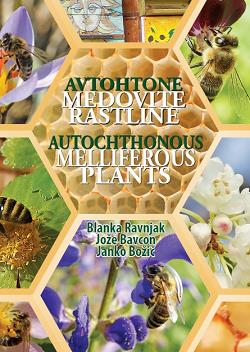
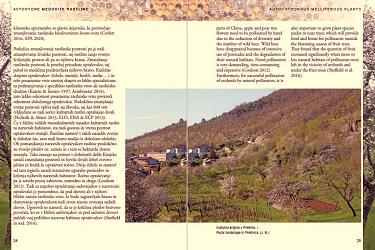
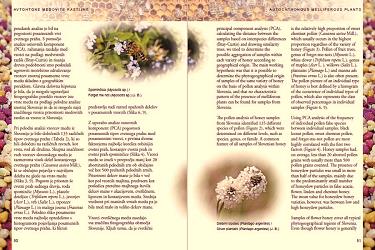
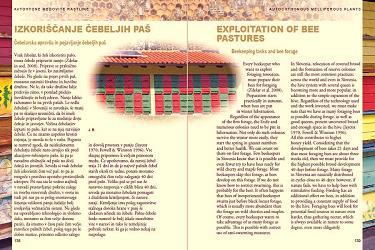
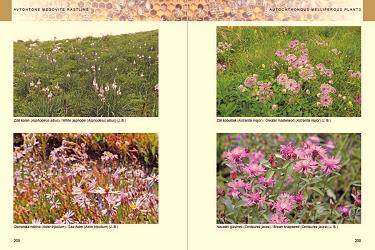
KAZALO VSEBINE
POSVETILO ... 12
RECENZIJA 1 ... 14
RECENZIJA 2 ... 18
UVOD ... 22
SOODVISNOST RASTLIN IN ČEBEL ... 26
KOMUNIKACIJA MED RASTLINO IN ČEBELO ... 32
MEDOVITOST IN MED ... 44
Prisotnosti pelodnih zrn v vzorcih slovenskega medu ... 48
AVTOHTONE MEDOVITE RASTLINSKE VRSTE ... 56
Opis nekaterih avtohtonih medovitih vrst ... 60
POZNA ZIMA ... 62
Navadni mali zvonček (Galanthus nivalis L.) ... 62
Spomladanska resa (Erica carnea L.) ... 64
Trobentica (Primula vulgaris Huds.) ... 66
Vse avtohtone vrste žafranov ... 68
Vse avtohtone vrste telohov ... 72
POMLAD ... 76
Borovnica (Vaccinium myrtillus L.) ... 76
Navadni regrat (Taraxacum officinale Weber in Wiggers) ... 78
POZNA POMLAD ... 80
Jesenček (Dictamnus albus L.) ... 80
Kukavičja lučca (Lychnis flos-cuculi L.) ... 82
Šipki (Rosa L.) ... 84
Travniška kadulja (Salvia pratensis L.) ... 86
POLETJE ... 90
Gadovec (Echium vulgare L.) ... 90
Grabljišče in grintavec (Knautia L. in Scabiosa L.) ... 92
Kobulnice (Apiaceae) ... 94
Kraški (Satureja montana L.) in liburnijski šetraj (Satureja subspicata subsp. liburnica Šilić) ... 96
Luki (Allium L.) ... 98
Mali talin (Thalictrum minus L.) ... 102
Navadna krvenka (Lythrum salicaria L.) ... 104
Navadni oslad (Filipendula vulgaris Mill.) ... 106
Navadna turška detelja (Onobrychis viciifolia Scop.) ... 108
Ozkolistno ciprje (Chamaenerion angustifolium (L.) Holub.) ... 110
JESEN ... 112
Jesenska vresa (Calluna vulgaris (L.) Hull) ... 112
Ožepek (Hyssopus officinalis L.) ... 114
Leska (Corylus avellana L.) ... 116
Vrbe (Salix L.) ... 118
Črni trn (Prunus spinosa L.) ... 120
Divja češnja (Prunus avium L. var. sylvestris (Kirsch.) Dierb.) ... 122
Rešeljika (Prunus mahaleb L.) ... 124
Javorji (Acer L.) ... 126
Kloček (Staphylea pinnata L.) ... 128
Mali jesen (Fraxinus ornus L.) ... 130
Bukev (Fagus sylvatica L.) ... 132
Lipa (Tilia platyphyllos Scop.) in lipovec (T. cordata Mill.) ... 134
Pravi kostanj (Castanea sativa Mill.) ... 136
IZKORIŠČANJE ČEBELJIH PAŠ ... 138
Čebelarska opravila in pojavljanje čebeljih paš ... 138
Kako čebele izkoriščajo pašne vire? ... 140
Kartiranje medovitih rastlin ... 144
Izbira stojišč ... 146
Fenogram medenja ... 148
Prevažanje čebel na pašo ... 150
SPREMLJANJE STANJA V OKOLJU S POMOČJO ČEBEL ... 152
NAČRTOVANJE ČEBELAM PRIJAZNEGA VRTA ... 162
Izbor lokacije ... 164
Koliko časa lahko namenim urejanju vrta? ... 170
Izbor rastlinskih vrst ... 172
Kaj pa zelenjavni vrt in njiva? ... 176
PRIMERI VRTOV Z AVTOHTONIMI MEDOVITIMI RASTLINAMI ... 182
Avtohtone medovite rastline v mestu ... 182
Vrt na poslovni stavbi ... 190
Vrt Čebelarske družine Šmarje pri Jelšah ... 192
Gimnazija Ledina ... 194
Vrt cvetočih preprog ... 196
Zelene nadstrešnice ... 200
SEZNAM AVTOHTONIH MEDOVITIH RASTLINSKIH VRST ... 204
PRILOGE ... 246
ZAHVALA ... 254
LITERATURA ... 256
STVARNO KAZALO ... 268
KAZALO SLIK ... 274
TABLE OF CONTENTS
DEDICATION ... 13
RECENZION 1 ... 15
RECENZION 2 ... 19
INTRODUCTION ... 23
INTERDEPENDENCE OF PLANTS AND BEES ... 27
COMMUNICATION BETWEEN PLANT AND BEE ... 33
NECTAR SOURCE AND HONEY ... 45
Pollen grain-content in Slovenian honey samples ... 49
AUTOCHTHONOUS MELLIFEROUS PLANTS ... 57
Description of some autochthonous melliferous species ... 61
LATE WINTER ... 63
Common snowdrop (Galanthus nivalis L.) ... 63
Spring heath (Erica carnea L.) ... 65
Primrose (Primula vulgaris Huds.) ... 67
All autochthonous species of crocuses ... 69
All autochthonous species of hellebores ... 73
SPRING ... 77
European blueberry (Vaccinium myrtillus L.) ... 77
Common dandelion (Taraxacum officinale Weber ex Wiggers) ... 79
LATE SPRING ... 81
Dittany (Dictamnus albus L.) ... 81
Ragged robin (Lychnis flos-cuculi L.) ... 83
Wild roses (Rosa L.) ... 85
Meadow clary (Salvia pratensis L.) ... 87
SUMMER ... 91
Viper’s bugloss (Echium vulgare L.) ... 91
Scabious and pincushion flower (Knautia L. and Scabiosa L.) ... 93
Umbellifers (Apiaceae) ... 95
Winter savory (Satureja montana L.) and Liburnian savory (Satureja subspicata subsp. liburnica Šilić) ... 97
Alliums (Allium L.) ... 99
Lesser meadow-rue (Thalictrum minus L.) ... 103
Purple loosestrife (Lythrum salicaria L.) ... 105
Fern-leaf dropwort (Filipendula vulgaris Mill.) ... 107
Common sainfoin (Onobrychis viciifolia Scop.) ... 109
Rosebay willowherb (Chamaenerion angustifolium (L.) Holub.) ... 111
AUTUMN ... 113
Heather (Calluna vulgaris (L.) Hull) ... 113
Hyssop (Hyssopus officinalis L.) ... 115
Heather (Calluna vulgaris (L.) Hull) ... 117
Willows (Salix L.) ... 119
Blackthorn (Prunus spinosa L.) ... 121
Wild cherry (Prunus avium L. var. sylvestris (Kirsch.) Dierb.) ... 123
Mahaleb cherry (Prunus mahaleb L.) ... 125
Maples (Acer L.) ... 127
European bladdernut (Staphylea pinnata L.) ... 129
Manna ash (Fraxinus ornus L.) ... 131
European beech (Fagus sylvatica L.) ... 133
Large-leaved linden (Tilia platyphyllos Scop.) and small-leaved linden (T. cordata Mill.) ... 135
Sweet chestnut (Castanea sativa Mill.) ... 137
EXPLOITATION OF BEE FORAGE ... 139
Beekeeping tasks and bee forage ... 139
How do bees exploit forage resources? ... 141
Mapping melliferous plants ... 145
Stand selection ... 147
Melliferous phenogram ... 149
Transporting bees to forage ... 151
ENVIRONMENTAL MONITORING USING BEES ... 153
PLANNING A BEE-FRIENDLY GARDEN ... 163
Location selection ... 165
How much time should I invest in arranging my garden? ... 171
Plant species selection ... 173
What about a vegetable garden and a field? ... 177
EXAMPLES OF GARDENS WITH AUTOCHTHONOUS MELLIFEROUS PLANTS ... 183
Autochthonous melliferous plants in the city ... 183
Garden on office building ... 191
Garden of the Beekeeping Family Šmarje pri Jelšah ... 193
Gymnasium Ledina ... 195
Garden of flowering carpet ... 197
Green bus shelter gardens ... 201
AUTOCHTHONOUS MELLIFEROUS PLANT SPECIES LIST ... 204
ATTACHMENTS ... 246
ACKNOWLEDGMENT ... 255
LITERATURE ... 256
INDEX ... 268
INDEX IMAGES ... 274





